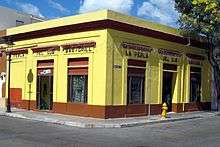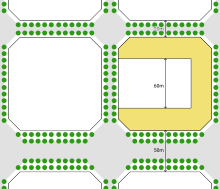Chamfer
A chamfer /ˈtʃæm.fər/ is a transitional edge between two faces of an object. A form of bevel, it is created at 45° angle to two adjoining right-angled faces. A lark's tongue is a chamfer which ends short of a piece in a gradual upward curve, leaving the balance as a right angle. Chamfers may be formed in either inside or outside adjoining faces of an object or room. They are also used to "ease" otherwise sharp edges, both for safety and to prevent damage to them.
By comparison, a fillet is the rounding-off of an interior corner, and a "round" (or "radius") the rounding of an outside one.[1]
"Chamfer" is commonly employed in mechanical and manufacturing engineering, and in poured-in-place concrete formwork. They are used in furniture such as counters and table tops to ease their edges; when rounded instead they are bullnosed. Special tools such as chamfer mills and chamfer planes are used.
Chamfers are necessary in parabolic glass mirror manufacture and desirable in certain printed circuit boards.
Architecture
Chamfers are commonly used in architecture, both for functional and aesthetic reasons. The base of the Taj Mahal is a cube with chamfered corners, thereby creating an octagonal architectural footprint. Its great gate is formed of chamfered base stones and chamfered corbels for a balcony or equivalent cornice towards the roof.[2]
Many city blocks in Barcelona, València and various other cities in Spain, and street corners (curbs) in Ponce, Puerto Rico, are chamfered. The chamfering was designed as an embellishment and a modernization of urban space in Barcelona's mid-19th century Eixample or Expansion District, where the buildings follow the chamfering of the sidewalks and streets. This pioneering design opens up broader perspectives, provides pleasant pedestrian areas and allows for greater visibility while turning. It might also be considered to allow for turning to be somewhat more comfortable as, supposedly, drivers would not need to slow down as much when making a turn as they would have to if the corner were a square 90 degrees, though in Barcelona, most chamfered corners are used as parking spaces or loading-unloading zones, leaving the traffic to run as in normal 90-degree street corners.
 A chamfered sidewalk street corner in historic Ponce, Puerto Rico
A chamfered sidewalk street corner in historic Ponce, Puerto Rico The Great gate (Darwaza-i rauza) gateway to the Taj Mahal, having chamfered tower corners
The Great gate (Darwaza-i rauza) gateway to the Taj Mahal, having chamfered tower corners A chamfered building and street corner on Barcelona's Passeig de Gràcia. Here the building is chamfered but the sidewalk/street has taken on a conventional, 90-degree layout, eliminating the loading zone or parking spaces.
A chamfered building and street corner on Barcelona's Passeig de Gràcia. Here the building is chamfered but the sidewalk/street has taken on a conventional, 90-degree layout, eliminating the loading zone or parking spaces. The original Barcelona Eixample city block design, showing the chamfered corners of buildings and streets, and including gardens that never materialized.
The original Barcelona Eixample city block design, showing the chamfered corners of buildings and streets, and including gardens that never materialized.
Other uses
In parabolic glass mirror design
Outside of aesthetics, chamfering is part of the process of hand-crafting a parabolic glass telescope mirror.[3] Before the surface of the disc can be ground, the edges must first be chamfered to prevent chipping. This can be accomplished by placing the disc in a metal bowl containing silicon carbide and rotating the disc with a rocking motion. The grit will thus wear off the sharp edge of the glass.
In printed circuit board (PCB) design
In printed circuit board (PCB) designing, a chamfer may be applied to a right-angled edge of a conductive junction in order to strengthen that location. Chamfering of junctions may also be applied in high-frequency PCB design in order to reduce reflections.[4]
See also
References
- ↑ Madsen et al., "Engineering Drawing and Design" page 179. Delmar, 2004 ISBN 0-7668-1634-6
- ↑ "Interior Decoration". Government of UP, Uttar Pradesh. Retrieved 2014-04-05.
- ↑ "How to Build a Telescope ?". IUCAA SciPOP. Retrieved 2017-12-31.
- ↑ Bogatin, Eric. "When to worry about trace corners: Rule of Thumb #24". EDN Network. UBM Canon. Retrieved 8 June 2015.
External links

